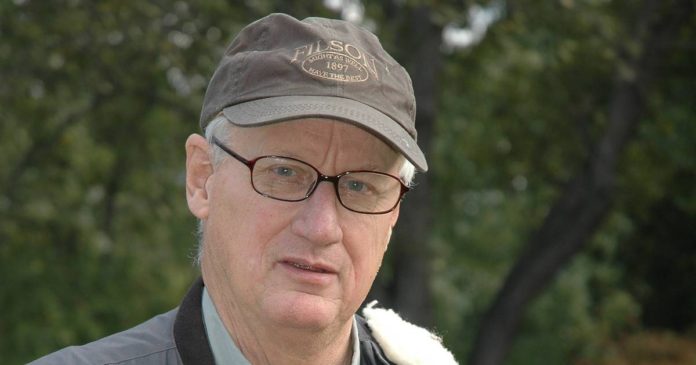C. Boyd Pfeiffer was a prolific and legendary outdoor writer and photographer for more than 40 years, authoring 23 books and thousands of articles for more than 70 magazines. He won numerous prestigious awards for his work and was an active member and often president of a number of outdoor writing organizations including Outdoor Writers Association of America and Mason-Dixon Outdoor Writers Association.
I first met Boyd in 1961 when we formed the Baltimore Anglers Club and were friends until his death two years ago. We only fished together occasionally but I have fond memory of some of those trips. The trips were fun but also business and were a real education for me. Most featured photos, fly tying, perks and stories. A week-long 1998 trip to Le Domaine Shannon (Shannon Lodge) for a 17-writers group sponsored by Tourisme Quebec included all four elements.
Every trip was a photo session with multiple shots from multiple angles. He sometimes brought extra hats and jackets to create a different photo even though the same fisherman and fish were the subjects.
On our last day in Quebec I was casting from the bow and heard the whirr of Boyd’s motorized Nikons (pre-digital age). When I asked what he was photographing, he simply said, “The scene.” When I saw his photos later I asked for one, and it turned out to be the cover shot for my story. It captured the whole spirit of the outing with the gray sky, wind riffled water, somber dark evergreens on shore, me casting with my bright blue satiny-sheen rain jacket and the motion of my water haul casts. Boyd saw the picture before shooting: I hadn’t.
But work and fun sometimes collided. One morning, intrigued by some of the lures we had been gifted, I broke out a spinning rod, attached a Red Eye Wiggler spoon and quickly hooked a brightly marked, 11-pound pike. Then the photo session began.
“Hold it this way!” “Move your hand!” “Point the fish more toward me!” Boyd kept issuing instructions while shooting pictures.
I was becoming more nervous. The pike was still squirming and was hooked only with the front double hook, leaving the large rear treble swinging dangerously free near my hands. Ignoring my pleas of “Hurry up, Boyd, this fish is still hot” Boyd kept issuing orders and getting more shots from different angles.
Finally he agreed for me to unhook and release the fish.
“That was crazy. I can’t believe I got away from that unscathed,” I said. “Yeah,” Boyd agreed. “I never would have done that.”
Overnight trips always featured evening fly tying sessions. Neither he nor I drank, played cards or bothered with TV when available.
Boyd developed a streamer fly he called “Pfeiffer’s Invincible” for bigger pike in Saskatchewan. He and I tied dozens of these, experimenting with sizes and colors, while kibitzers offered suggestions and stories were exchanged. By the third day we had created the magic fly, whittled down from the original 12-inch version to a 6-7 inch version, all white, tied on a long-shanked 2/0 hook with eyes, a fiber spun body, and an artificial streamer hair tail with a little flash material.
We experimented with spoons, spinner, plugs and with other flies during the week but none of them came close to matching our magic fly fished on sinking lines for pike and the occasional over-ambitious walleye.
I learned to expect the best treatment when I fished with Boyd. In Quebec, our guide was the lodge owner’s son, Sylvain Demis, and he took us to some special lakes not available to the other writers. Often we had a lake to ourselves. On a later trip to Pulaski, New York, wade fished for steelhead, local tourism friends of Boyd gifted our group of four with a two-boat drift fishing trip on Niagara River for lake trout and salmon.
Carroll County Daily Headlines
Daily
Get the day’s top news and sports headlines.
Boyd was a consummate raconteur.
One of my favorites stories was his account of carp fishing on the Potomac with a friend in his leaky aluminum boat. Every half hour or so they had to stop fishing, bail out the water and caulk the boat’s seams and holes with some of the carp dough they were using for bait.
Providing photo coverage for a BASS tournament, Boyd related the following exchange at the press briefing. A newspaper reporter asked if any of the anglers was apprehensive about taking their comparatively small boats out on Lake Superior. A southern good old boy responded that their bass boats were tough and could handle any water. To which the reporter responded, “Have you ever heard of the Edmund Fitzgerald?” (The Edmund Fitzgerald was a 729-foot Great Lakes freighter that sank in Superior in a gale and was memorialized in a ballad by Gordon Lightfoot.)
Then there was the time in Central America when his crew encountered bandits. For two days Boyd had to take his turn on guard duty with a shotgun while having to subsist on colas and candy bars until the situation was resolved.
And the time beating back to port after a sea trout outing on Delaware Bay while the bilge pump ran constantly and Boyd and the other fisherman bailed the whole time. When they went to the dock the next morning they found the seaworthy aluminum boat had sunk; the constant pounding created a large split in the keel.
Those were the days.
As Red said in “Shawshank Redemption,” “I miss my friend.”
Credit: Source link































